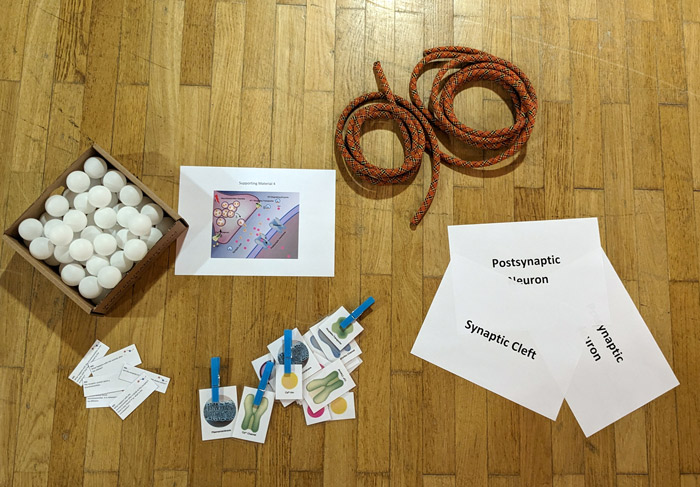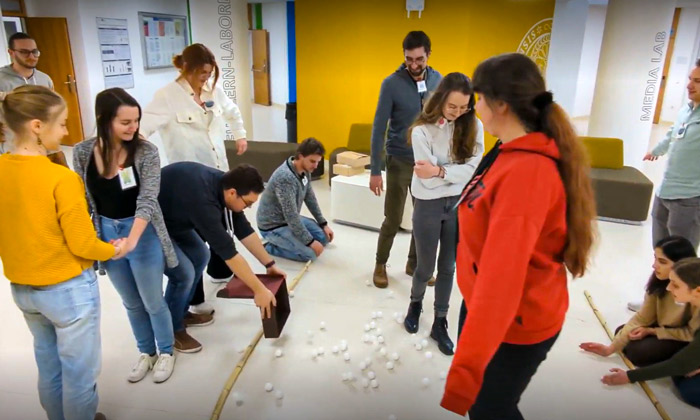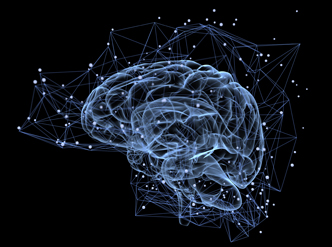Supporting materials
Synaptic transmission infosheet
Download
Download this article as a PDF

Play the part: students take on the roles of different components of a synapse to act out synaptic transmission and learn about neurobiology.
Teaching neurobiology to students can often be challenging. In fact, neurophysiological topics are some of the most difficult concepts that students and teachers in school are confronted with. With topics this complex, many teachers tend to switch on ‘here are the facts, just memorise them’ mode. For that, we use textbooks, in which the electrochemical processes are reduced to a mere list of numerous steps, often accompanied by figures with overwhelming complexity.
In the activity presented here, students take on the roles of different components of a synapse to act out synaptic transmission.
It is generally accepted that active learning increases students’ motivation and leads to better performance in various scientific disciplines.[1,2] Moreover, moving around in a classroom, taking part in a role play involving interactions with other students, can enhance the level of activity to the point where students are, in general, more attentive.[3]
This activity allows teachers to differentiate between students who need more guidance and those already familiar with active teaching methods. It is a valuable way to investigate synaptic transmission alongside the classic learning track and can be easily incorporated into a traditional teaching unit with hardly any additional costs.
The hands-on activity outlined here is suitable for students aged 14–19 and adaptable for a group of 10–18 students. With more students, split them into two groups.
Students will need approximately 10–15 min for the introduction (this can also be set as homework) and 40 min for the rest of the task.
At the end of the activity, students are encouraged to save their results by producing a short video of their synaptic model role play.
The activity cards can be provided at three complexity levels to make the activity adaptable to different student ages and abilities.
| Complexity level | Supporting material |
|---|---|
| Level 1 (easy) | Acting cards with a short description (the number of acting cards is already fixed) plus the synapse diagram |
| Level 2 (medium) | Role labels without description |
| Level 3 (difficult) | Blank acting cards to be filled out by the students |

| Misconception card | Misconception |
|---|---|
| M1 | The neurotransmitters (table tennis balls) are thrown on target |
| M2 | The receptor/ion channel catches the neurotransmitter |
| M3 | The neurotransmitter binds permanently to the receptor |
| M4 | The vesicles stay in the synaptic cleft |
| M5 | The neurotransmitter stays permanently in the synaptic cleft |
| M6 | The neurotransmitter-degrading enzymes are only active at the end of the role play (after the neurotransmitter has bound to the receptor) |

It is important that students understand the model they have created and that any misconceptions are discussed during the process of acting out synaptic transmission. The social dialogue between the students and teacher should also be a focus.
A substantial body of literature has demonstrated that the application of nonconventional approaches, such as games and role play, stimulates learning.[2–5] We recommend that during the performance students work on their own and teachers try not to interfere at all. It is important that all students are familiar with the topic before they start the role play. Otherwise, the role play tends to end in confusion.
Finally, the created videos can be used as a template for several follow-up lessons dealing with drugs, diseases, or the concept of inhibitory and excitatory synapses.
[1] Glynn SM, Price Aultman L, Owens AM (2005) Motivation to learn in general education programs. The Journal of General Education 54: 150–170. doi: 10.2307/27798014
[2] Prince M (2004) Does active learning work? A review of the research. Journal of Engineering Education 93: 223–231. doi: 10.1002/j.2168-9830.2004.tb00809.x
[3] Kumar R, Lightner R (2007) Games as an interactive classroom technique: perceptions of corporate trainers, college instructors and students. International Journal of Teaching and Learning in Higher Education 19: 53–63.
[4] Franklin S, Peat M, Lewis A (2003) Non-traditional interventions to stimulate discussion: the use of games and puzzles. Journal of Biological Education 37: 79–84. doi: 10.1080/00219266.2003.9655856
[5] Simon-Dack SL (2014) Introducing the action potential to psychology students. Teaching of Psychology 41: 73–77. doi: 10.1177/0098628313514183

What are slime moulds? And what do they eat for breakfast? Discover these fascinating giant microbes and explore chemotaxis and the scientific method with these slimy experiments.

Basic research is often misunderstood by the public and misconstrued by the media. Try this role play to learn how research is funded and how basic…

Insights into the brain’s unique protective barrier could offer promising treatments for diseases such as multiple sclerosis and…